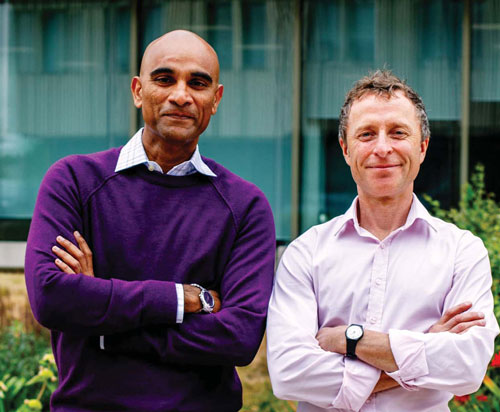IoT is an ecosystem under construction but companies are making moves to bring more capabilities together and go to market with consolidated offerings. One of the latest moves has seen Arm, the provider of device chipset IP and IoT software and services such as device management, acquire Stream Technologies, the originator of the IoT-X connectivity management platform. Switfly after this deal was announced, Arm made a further acquisition of enterprise data management company, Treasure Data. Technologies from Treasure Data will be combined with the Arm Mbed platform and Stream’s technologies to form an end-toend IoT connectivity, device and data management platform, called the Arm Pelion IoT Platform. The new platform will enable organisations to quickly, securely and sustainably create actionable insights from IoT, enterprise and third-party data.
Here, Hima Mukkamala, the senior vice president and general manager of IoT cloud services, Arm and Nigel Chadwick, the former chief executive officer of Stream and now the senior director of connectivity, IoT Services Group, Arm, tell IoT Now their reasons for the deal and how they see it benefiting customers across the IoT.
IoT Now: Please tell me about Arm and what the company does?

Arm
Hima Mukkamala: When most people think of Arm and our history, they know us for our efficient and small-form factor chip IP designs that are used in more than 95% of mobile phones, as well as in automotive, servers, healthcare, smart wearables and more. In fact, our partners have shipped more than 125 billion Arm-based chips, and we expect 1 trillion connected devices to ship by 2035. When you think of this scale of connected devices shipping, the challenge facing the market is how to manage the spread of IoT devices and use cases. We therefore started to think about how to give our customers ways to manage connected devices. For example, Zebra in the US has tens of millions of mobile computers, barcode scanners and printers for its users. Scaling that to serve a use case such as agriculture requires the ability to manage an ecosystem of user devices, but also sensors on equipment and that is going to be challenging to manage.
Arm therefore decided to make strategic investments to solve the problem. The fundamental value proposition we started with was how to simply scale and manage this IoT landscape. Every IoT device is a connected device and customers want help with security and connectivity, in a˚ddition to device management, so we’ve continued to build out our solutions to help customers with these challenges.
As Arm, we’ve segmented our business into two main sections. One is the traditional chip IP business and the other is this IoT services business to manage devices and address the challenges we see in the IoT market.
IoT Now: What do you see as the key trends emerging in IoT?
HM: If you look at KEPCO, the largest utility in South Korea, it needs to manage 20 million smart meters and be able to provision these with the right security credentials, ensure firmware is updated and then seamlessly make them come online and send data into the cloud so decisions can be made.
These are large and complex projects and we typically see IoT ecosystems or deployments affected in three key ways. One is the immense fragmentation of devices used in IoT. They can range from a 20c sensor to measure temperature to monitoring of a US$20m jet engine so how do you manage based on this vast spread of service value?
A second trend is that, at the other end of the spectrum, we need to make decisions at the closest point of action. The ability to deploy software there is needed to enable the technology to drive value.
Finally, the problem of the vast volume of data generated in IoT needs to be addressed. Typical analyst estimates find that 80% of companies will fail to monetize their IoT data. The challenge is to create the ability to handle any type of data.
IoT Now: With this in mind, what attracted you to acquire Stream Technologies?
HM: In talking with customers in the logistics and utilities industries, we discussed the value proposition of device management we were delivering before Stream. Customers would frequently ask us to recommend a connectivity management company. KEPCO smart meters are deployed all over the country and Zebra devices are deployed in many different environments so how do you help companies connect across multiple protocols including cellular, narrowband IoT (NB-IoT), LoRaWAN or even Wi-Fi?
We started looking at how to deliver this in a single pane of glass to show how devices are managed and also connected. If you’re going to deploy millions of devices and each will push one megabyte of data, the ability to ensure that the devices are running properly and connected to the right networks is golden. That’s why Stream’s connectivity management capabilities fit so well – people want a single pane of glass to manage devices and connectivity.
Aside from this, Stream fits well with our culture as a company, which is a huge positive. The teams work really well together. It’s a combination of the right business value and the right cultures coming together.
IoT Now: Nigel, what is Stream’s view of the acquisition? Why did you agree to the deal with Arm in preference to other suitors?

Arm
Nigel Chadwick: I’ve talked many times about the fragmentation of the sector and the need for the consolidation of technologies. We saw a lot of value and very positive attributes with Arm in the range of technologies they have. The merging of Arm’s technologies with what we have in Stream with our connectivity platform and abilities, which are agnostic to wireless protocol, presents an extremely good technical fit.
Arm also has the scale, global reach and expertise along with a tremendous vision that was aligned to our own. Using the connectivity and platform as a service (PaaS) capability integral to our IoT-X platform, it doesn’t get much better than having the ability to combine that with Arm’s technologies to open up some incredible opportunities. The cultural fit between the two companies both pre and post acquisition has been amazing, there is a dynamic, people-oriented culture.
IoT Now: How have your customers responded to the acquisition?
NC: For the enterprise clients of Stream, the global reach we now have is particularly appealing. The single pane capability, the management of different technologies and making it easier to build out IoT apps is gaining credence amongst existing clients and gaining significant interest from largescale enterprises.
HM: This is something that every customer I talk to worries about. They want the end-toend solution that we’re building. The other value that customers new or old get is that we have enormous capability to get to the mobile operators and to make it seamless for them. Our owner is Japanese mobile operator Softbank and its vast Vision Fund provides us with access to a number of companies to deliver better value for customers. Being part of Softbank enables us to bring these capabilities together.
NC: We’ve talked about direct connectivity, but the PaaS play is very alluring as well. IoT-X enables network operators to generate demand and ease the whole management process of IoT connectivity. I view our technology as a glue across the IoT ecosystem that will accelerate the global growth of IoT.
IoT Now: Can you give examples of how customers use Stream technology and how this enables them to do more?
NC: The early feedback we’ve been getting is about the extension of the technologies we’re managing together. We have connectivity customers through Stream that are interested in adding device management and security too. Doing this with a large, trusted brand like Arm is changing the way of thinking. Our customers would previously have had to select multi-vendor solutions, but now customers are keen to combine technologies into a single pane.
HM: Stream has a lot of utility company customers and utilities are one of our biggest verticals from a device management point of view. We understand the ecosystem of smart meters and we see the requirements clearly. This combination now gives better value in the unified verticals we’re trying to go to.
There’s a lot of opportunity in logistics and connected spaces and all need connectivity management.
IoT Now: How do you see this market place developing in the future?
HM: If you think about customer problems on any device and any cloud with any data, this technology plays an immense role in solving them. Stream is a fundamental addition to our business, and a key aspect of the value we offer and how we will grow our business. In the next year or so, we will bring the single pane of glass to market.
From a business standpoint, we’re pretty bullish about how we will take what we have and add the scale of Arm and Softbank to Stream to give lower total cost of ownership and development costs.
NC: In addition to what Hima has said, we will see hardware proliferation driven from a sensor perspective and also a much more effective ecosystem being created so network operators can accelerate their IoT plays.
For many years, analysts have talked about a huge number of connected IoT devices, but there needs to be a step change in consolidating technologies in a seamless way to generate the big numbers that have been talked about. We believe this could be the start.










